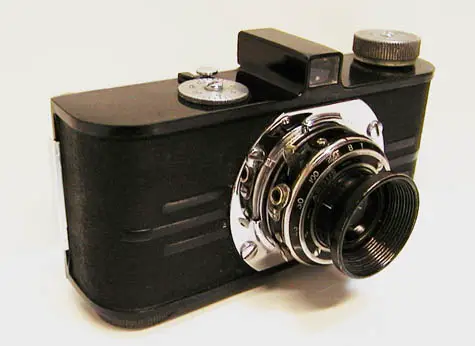- Produced 1936-41 International Research Corporation, Ann Arbor, MI USA
- Film type 135 (35mm)
- Picture size 24 x 36mm
- Weight 13.5 oz (382.7g)
- Lens Argus Anastigmat 50mm 1:4.5 (3 element), collapsible
- Focal range 6′ to infinity in two zones
- Shutter leaf
- Shutter speeds T, B, 1/25, 1/50, 1/100, 1/200
- Viewfinder viewfinder
- Exposure meter none
Overview
I resisted this ultra-classic cutie for a long time, despite my own whisperings and the less-subtle persuasion of my good friend Ken Smith, who really enjoys his Argus AF (focusing model). I finally succumbed after a now-retired colleague from work — and fellow phototgrapher — found a couple of old Argus cameras in a box in his rafters, relics from the house’s previous owner. He asked if I would clean them up so that he could try to use them and of course I agreed. One was an original A and the other an original C. So on a Friday night during a repeat viewing of Men in Black on DVD I carefully removed 40 years of dirt from the two classics, made them pretty and tested them. And then suddenly realized I had to have an A of my own. Small, light, classic Art Deco styling — what’s not to like?
The Argus A’s place in history is secure. It was a radio company’s inspired foray into consumer-level camera-making, which proved so popular that International Radio Corporation sold off its radio manufacturing business to concentrate on camera-making as ‘International Research Corporation’, then rebranding to the name of their flagship (pun fully intended) Argus line. The A’s runaway success was largely due to its cheap price in tough economic times — this Leica-A inspired plastic classic (actually bakelite) basically brought 35mm photography to the masses.
The A was updated into other models over the years — focusing capability was added at one point (AF), an extinction meter at another (A2) — a few different shutters were used as well, from no-name to Ilex Precise to Prontor. Apparently I’m lucky to have a slightly improved later A that has a double-sprocket guide wheel, the only way to fly. (I didn’t know there was any other kind!) A spring-loaded pressure plate would have been nice, though that didn’t come till later.
As with many of the old Argi, because of their ubiquity and antiquity, the price is usually still nice — I won mine in online auction for $5, which included a nice leather case, usually a sign of a well-protected instrument. Emphasis on the “usually”. Sure, I could have held out for the more collectible AF (focusing A) but I thought that for convenience’s sake I’d be more likely to use a fixed-focus lens. Besides, I can always get another 😉
TURNS OUT though that this isn’t the fixed-focus lens I thought it was, it’s a zone focus lens in two zones, nominally 6 to 18 feet and 18 feet to infinity according to the manual. HOWEVER that must mean stopped-down because a check with a loupe and glass at the film plane makes it seem more like 5 feet to 10 feet and 10 feet to infinity… wide open anyway. The first zone (NEAR) is with the lens extended and locked in place. The far zone is with the lens extended and NOT locked. Kind of opposite of what you’d expect. Important to know!
Speaking of the lens, this three-element ‘Argus Anastigmat’ is surprisingly good, despite being uncoated and showing occasional vignetting. My question – where did the design come from? It’s one thing for someone with plastic moulding experience to come up with an inspired design for a new camera, but how does a former plastics company come out of the starting gate with a fairly complex and cutting-edge optical formula? Food for thought.
Another odd thought – the manual shows a man holding this camera with the viewfinder ON THE BOTTOM, saying it was the recommended way of holding the camera to ‘the bony part of the face’. I don’t recommend that myself. Hard enough to hold the thing still while you press the shutter lever!
PS – the rest of the story is that my Argus-endowed colleague paid me in film for my efforts, so of course I had to use some of that (HP5 plus) to break in my own Argus A. Turns out however that it’s best to match a slow lens-shutter combination with slow film to avoid gross overexposure, you’d think I would have remembered that from my Adventures with Photax.
Repairs
Pretty filthy, with tarnished brass, cloudy glass, a missing screw and hardened foam. Gee, what was I expecting for my $5 anyway? Cleaned up all the tarnished metal parts with Circle 7 polishing compound (great stuff!), including the back; cleaned the glass with Windex, and replaced the hardened foam in the back door with a 1cm x 5cm piece of neoprene from a mousepad. Replaced the nameplate screw with one from a busted Petri. The good news: the ancient shutter seems pretty good, the apertures stop down apparently correctly, and the glass looks clear now that it’s clean.
Tips & Tricks
See above for info regarding the two-zone focus. My advice is to check the ranges yourself with a loupe and ground glass to make sure the zones are where you think they are. Put a sticky note on the back of the camera if you need to.
The relatively slow lens and shutter mean that this camera is well-suited to slower films like 125 or below; the fact that the lens is uncoated means that colors may lack contrast and lens may be prone to flare. Luckily mine came with a R@RE-L@@K! press-on metal lens hood, that alone is probably worth the $5!
Related Links
- How to fix the Ilex Precise shutter
- Argus Collector’s Group
- Cameraquest’s take on this uber-classic
- Another interesting page on the Argus A
